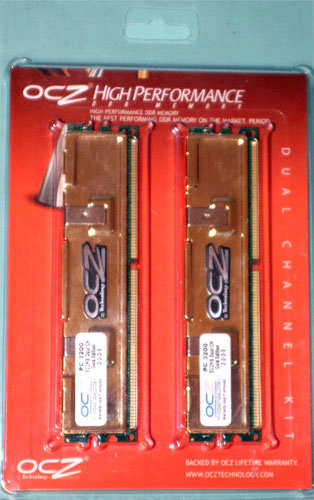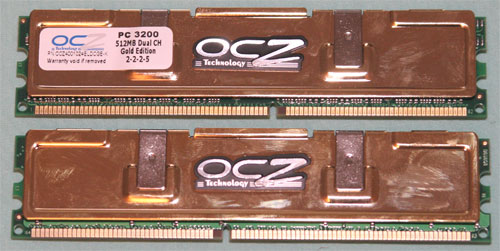Value RAM Roundup: Computing On a Budget
by Wesley Fink on April 11, 2005 4:26 PM EST- Posted in
- Memory
OCZ PC3200 Gold: "Value BH5"
When OCZ submitted three different memories for this Value RAM roundup, we first thought it was overkill and an attempt to hijack the roundup. However, as we looked closer at the three memories and the benchmark results with all 3, it is clear that these are memories aimed at 3 different market segments. While all three meet our requirement of costing less than $200 for a Gigabyte, the PC3200 Premier is the more traditional Value RAM that will work on almost any motherboard. The second OCZ memory, PC3200 Gold, will appeal to the enthusiast - particularly those enthusiasts who foam at the mouth over OCZ VX at 3.6V.

Specifications
OCZ PC3200 Gold is the only memory in the Value RAM roundup to be rated at 2-2-2-5 timings.| OCZ PC3200 Gold (DDR400) Memory Specifications | |
| Number of DIMMs & Banks | 2 DS |
| DIMM Size Total Memory |
512 MB 1GB |
| Rated Timings | 2-2-2-5 at DDR400 |
| SPD (Auto) Timings | 2-3-2-5 |
| Rated Voltage | 2.6V |
The SPD is set for "auto" timings to 2-3-2-5. To achieve full 2-2-2 timings, you need to adjust memory timings in BIOS. This is the first opportunity that we have had to test BH5 with high memory voltages. The DFI nForce4 SLI has adjustments to 4.0V in BIOS, so we were able to see for ourselves if the BH5 legends were really true.
Test Results
3.4V is hardly the kind of voltages available on most motherboards - particularly those boards that might use Value RAM. To get this kind of voltage, you need a production DFI nForce4 board - Ultra at about $133 or SLI for $184 to $215. You can also achieve these voltages on many motherboards with an OCZ DDR Booster at about $40. What you can do with voltage and BH5, however, is amazing.| OCZ PC3200 Gold (DDR400) - 2 x 512Mb Double-Bank | |||||||
| CPU Ratio at 2.4GHz | Memory Speed |
Memory Timings & Voltage |
Quake3 fps |
Sandra UNBuffered | Sandra Standard Buffered |
Super PI 2M places (time in sec) |
Wolfenstein - Radar - Enemy Territory fps |
| 12x200 | 400 DDR | 2-2-2-6 2.6V 1T |
568.9 | INT 2984 FLT 2960 |
INT 6100 FLT 6095 |
81 | 120.0 |
| 11x218 | 436 DDR | 2-2-2-6 2.8V 1T |
580.0 | INT 3053 FLT 3132 |
INT 6486 FLT 6413 |
81 | 122.3 |
| 10x240 | 480 DDR | 2-2-2-6 3.1V 1T |
596.7 | INT 3234 FLT 3241 |
INT 6731 FLT 6769 |
80 | 124.6 |
| 11x255 (2.8GHz) |
Highest CPU/Mem Performance 510 DDR |
2-2-2-7 3.4V 1T |
636.5 | INT 3359 FLT 3517 |
INT 7575 FLT 7493 |
69 | 133.5 |
The original BH5 was great up to about DDR450 at decent timings. Above that, it quickly gave out of range - or at least we thought it did in those days. It appears that BH5 with voltage allows 2-2-2 timings to be maintained to levels over DDR500. Frankly, for most users searching for Value RAM, this OCZ PC3200 Gold should be considered as very good and useful to about DDR450 to DDR460, at voltages of 2.9V and lower with very good 2-2-2 to 2.5-3-2 timings. Mad overclockers can consider this an incredible bargain. Feed this value BH5 the voltage and it will deliver at 2-2-2 timings. If you have one of the DFI nForce4 boards, this is one of the memories that can show off what high memory voltage can do.
We have found Aida benchmarks to be very useful in examining read/write performance and memory latency. Aida 32 is now available as Everest Home Edition, a free download from www.lavalys.com.
| OCZ PC3200 Gold (DDR400) 2x512Mb Double-Bank Everest 1.51 |
|||||
| CPU Ratio at 2.4GHz | Memory Speed | Memory Timings & Voltage |
Everest READ MB/s |
Everest WRITE MB/s |
Everest Latency ns |
| 12x200 | 400 DDR | 2-2-2-6 2.6V 1T |
5892 | 2027 | 45.8 |
| 11x218 | 436 DDR | 2-2-2-6 2.8V 1T |
6275 | 2135 | 43.4 |
| 10x240 | 480 DDR | 2-2-2-6 3.1V 1T |
6803 | 2323 | 39.5 |
| 11x255 (2.8GHz) |
Highest CPU/Mem Performance 510 DDR |
2-2-2-7 3.4V 1T |
7268 | 2460 | 37.0 |
Maintaining a constant CPU Speed of 2.4GHz and constant memory timings of 2-2-2, we measured the impact of increasing the Memory Speed from 200 to 240, a 20% increase. Both Memory Read and Memory Write performance increased by about 15%, while Latency improved by a similar 14%. This translated into improvement in game FPS from 4% to 5% at a constant CPU speed.










102 Comments
View All Comments
ChineseDemocracyGNR - Tuesday, April 12, 2005 - link
#39,"2) RAM multipliers are usually limited. If you have a standard set of 400, 320, and 266 speeds, you could only achieve DDR400 speed at a CPU frequency of 250. Anything lower than that would be running the RAM at less than 400. Most A64 CPUs can't do 250 on air at stock multipliers (the low end ones can) so they will be running less than optimum ram speed. That's where you could lower CPU multipliers or use a board like the DFI with lots of intermediate RAM ratios. "
I'm not sure I'm following.
With a 9x CPU multiplier, DDR266 memory divider and 312MHz reference clock the memory would be running at DDR400.
With a DDR200 option you could go up to 400MHz on the reference clock. That means that no DDR400 memory will limit the overclock of a CPU with a 9x multiplier.
"1) There is an Asynchronous Latency penalty, which can be tweaked somewhat on boards with better BIOS options like the DFI. It is not, hoever, the kind of asynchronous penalty you see on a FSB board like Intel. "
In my own tests there's no real-world penalty at all. I compared an Athlon 64 running at:
REFCLOCK: 200MHz
Memory Divider: DDR400
CPU multiplier: 9x
LDT: 5x
with:
REFCLOCK: 300MHz
Memory Divider: DDR266 (DDR400 effective)
CPU multiplier: 6x
LDT: 3x
The results where near identical.
"In other words, the easiest way to consistently improve memory performance is 1:1 memory speed."
There's no memory fast enough to run at 1:1 with an Athlon 64. ;)
An Athlon 64 at 9*200 is on a 1800/9 ratio with DDR400 memory.
I'm sorry but I stand by what I said before, there's no reason to invest in memory if you want to overclock your Athlon 64, only if you want to overclock the memory as well.
Kind of on the subject, I hope the round up of AMD PCI-E boards (there is one coming right?) tests the best reference clock the motherboards can achieve without memory as a limiting factor, unlike the reviews before.
PrinceGaz - Tuesday, April 12, 2005 - link
Excellent review, both for the modules it covered and what it didn't.One small point- there is no such thing as 1:1 memory timings with A64 processors. The reduced latency and higher performance that a 1:1 ration gave when the processor to chipset FSB was running synchronously with the chipset memory-controller, is irrelevant with the Athlon 64 as there is no intermediate bus operating at a differnt speed to the memory controller to cause overheads. Selecting a lower memory speed just changes the CPU:Memory ratio in the processor.
The memory on an Athlon 64 system works just as efficiently (though ay a lower bandwidth of course) if set to DDR333 as it does at DDR400, which means there is no real penalty when overclocking in choosing a lower memory speed to compensate for the increasing bus speed.
Olaf van der Spek - Tuesday, April 12, 2005 - link
http://anandtech.com/memory/showdoc.aspx?i=2392&am...> Transcend is another memory that costs just $100 for a Gigabyte and yet manages to nearly reach DDR550 in overclocking.
550?
The table claims 510 (2 x 223), but 2 x 223 = 446.
Olaf van der Spek - Tuesday, April 12, 2005 - link
Is Lavalys sponsoring this article? Why is that paragraph repeated on every page?JustAnAverageGuy - Tuesday, April 12, 2005 - link
I would have liked to see Mushkin Blue($147 per GB)
http://www.newegg.com/app/viewproductdesc.asp?desc...
and Corsair VS 2.5
($174 per gb)
http://www.newegg.com/app/ViewProductDesc.asp?desc...
I won't whine about the voltage, that's been done before :)
Olaf van der Spek - Tuesday, April 12, 2005 - link
-LX - Tuesday, April 12, 2005 - link
Why isn't the OCZ4001024WV3DC-K on the OCZ site???CobraT1 - Tuesday, April 12, 2005 - link
If you are interested in the OCZ Value VX, note the differences in the two part numbers, one with a "W" and one without.Value VX = OCZ4001024WV3DC-K
2.5-3-3-7 (picture) Supports EVP (Extended Voltage Protection)
Value = OCZ4001024V3DC-K
3-4-4-8 Does not Support EVP
See this link for both.
http://www.newegg.com/app/searchProductResult.asp?...
Hope this clears up the confusion.
segagenesis - Tuesday, April 12, 2005 - link
Wesley - Fair enough. But when that ATACOM link posted in #44 shows 3-4-4 even on the label in the picture its hard to tell who to believe (and its hard to read the part # on it). If its all the same chip then fine... but why label it differently then? Buyer beware?Maybe I am off base...
Turin39789 - Tuesday, April 12, 2005 - link
I get real tired pushing ferrari's out of my driveway. There isnt any racing alcohol available to me, sometimes I have my neghbor tow me to work in his chevrolet cobalt